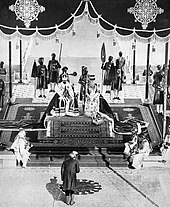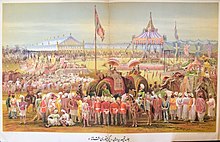I am giving below the details of all three Imperial Darbars organized by Britishers on Indian soil. The Britishers extravaganza was repeatedly celebrated with dazzling pump and show. That’s how the looted money from our land was littered away in typical style with elements of burlesque. The local kings and emperors mostly were made to bow before the Imperial monarchs.
Enjoy the details of three Darbars below:
The Delhi Durbar (meaning "Court of Delhi") was an Indian imperial-style mass assembly organized by the British at Coronation Park, Delhi, India, to mark the succession of an Emperor or Empress of India. Also known as the Imperial Durbar, it was held three times, in 1877, 1903, and 1911, at the height of the British Empire. The 1911 Durbar was the only one that a sovereign, George V, attended. The term was derived from the common Mughal term durbar.

Durbar of 1877

Called the "Proclamation Durbar", the Durbar of 1877, for which the organisation was undertaken by Thomas Henry Thornton, was held beginning on 1 January 1877 to proclaim Queen Victoria as Empress of India by the British. The 1877 Durbar was largely an official event and not a popular occasion with mass participation like later durbars in 1903 and 1911. It was attended by the 1st Earl of Lytton—Viceroy of India, maharajas, nawabs and intellectuals. This was the culmination of transfer of control of British India from the East India Company to the Crown.
Inside the Victoria Memorial in Calcutta is an inscription taken from the Message of Queen Victoria presented at the 1877 Durbar to the people of India:
We trust that the present occasionmay tend to unite in bonds of close
affection ourselves and our subjects;
that from the highest to the humblest,
all may feel that under our rule the
great principles of liberty, equity,
and justice are secured to them; and
to promote their happiness, to add to
their prosperity, and advance their
welfare, are the ever present aims and
objects of our Empire.
The Empress of India Medal to commemorate the Proclamation of the Queen as Empress of Indiawas struck and distributed to the honored guests, and the elderly Ramanath Tagore was raised to the status of an honorary Raja by Lord Lytton, viceroy of India.
It was at this glittering durbar that Ganesh Vasudeo Joshi, wearing "homespun spotless white khadi" rose to read a citation on behalf of the grass roots native political organization, the Poona Sarvajanik Sabha, which organization presaged the later rise of the Indian National Congress. Joshi's speech put forth a demand couched in very polite language:
Her Majesty to grant to India the same political and social status as is enjoyed by her British subjects.
With this demand, it can be said that the campaign for a free India was formally launched, which was the beginning of a great transformation for India.
The durbar would later be seen as controversial because it directed funds away from the Great Famine of 1876–78.
Durbar of 1903

The durbar was held to celebrate the succession of Edward VII and Alexandra of Denmark as Emperor and Empress of India.
The two full weeks of festivities were devised in meticulous detail by Lord Curzon, Viceroy of India.[6] It was a dazzling display of pomp, power, and split-second timing. Neither the earlier Delhi Durbar of 1877, nor the later Durbar held there in 1911, could match the pageantry of Lord Curzon's 1903 festivities. In a few short months at the end of 1902, a deserted plain was transformed into an elaborate tented city, complete with temporary light railway to bring crowds of spectators out from Delhi, a post office with its own stamp, telephone and telegraphic facilities, a variety of stores, a Police force with specially designed uniform, hospital, magistrate's court and complex sanitation, drainage, and electric light installations. Souvenir guide books were sold and maps of the camping ground distributed. Marketing opportunities were craftily exploited. A special Delhi Durbar Medalwas struck, firework displays, exhibitions and glamorous dances held.
Edward VII, to Curzon's disappointment, did not attend but sent his brother, the Duke of Connaught who arrived with a mass of dignitaries by train from Bombay just as Curzon and his government came in the other direction from Calcutta. The assembly awaiting them displayed possibly the greatest collection of jewels to be seen in one place. Each of the Indian princes was adorned with the most spectacular of his gems from the collections of centuries. Maharajahs came with great retinues from all over India, many of them meeting for the first time while the massed ranks of the Indian armies, under their Commander-in-Chief Lord Kitchener, paraded, played their bands, and restrained the crowds of common people.[7]
On the first day, the Curzons entered the area of festivities, together with the maharajahs, riding on elephants, some with huge gold candelabra stuck on their tusks. The durbar ceremony itself fell on New Year's Day and was followed by days of polo and other sports, dinners, balls, military reviews, bands, and exhibitions. The world's press dispatched their best journalists, artists and photographers to cover proceedings. The popularity of movie footage of the event, shown in makeshift cinemas throughout India, is often credited with having launched the country's early film industry.
The India Post issued a set of two commemorative souvenir sheets with special cancellation struck on 1 January 1903 – 12 noon, a much sought-after item for the stamp collectors today.
The event culminated in a grand coronation ball attended only by the highest-ranking guests, reigned over by Lord Curzon and Lady Curzon in her jewels and peacock gown.
Durbar of 1911

On 22 March 1911, a royal proclamation announced that the Durbar would be held in December to commemorate the coronation in Britain a few months earlier of George V and Mary of Teck and allow their proclamation as Emperor and Empress of India. Practically every ruling prince and nobleman in India, plus thousands of landed gentry and other persons of note, attended to pay obeisance to their sovereigns.
The official ceremonies lasted from 7 to 16 December, with the Durbar itself occurring on Tuesday, 12 December.[11] The royal couple arrived at Coronation Park in their Coronation robes, the King-Emperor wearing the Imperial Crown of India with eight arches, containing 6170 exquisitely cut diamonds, and covered with sapphires, emeralds and rubies, with a velvet and miniver cap all weighing 34 ounces (965 g). They received homage from the native princes – including one woman, the Begum of Bhopal – at the shamiana (ceremonial tent); controversy ensued when the Gaekwar of Baroda, Maharajah Sayajirao III, approached the royal couple without his jewellery on, and after a simple bow turned his back to them when leaving. His action was interpreted at the time as a sign of dissent to British rule.[12] Afterwards, the royal couple ascended to the domed royal pavilion, where the King-Emperor announced the move of India's capital from Calcutta to Delhi. The annulment of the Partition of Bengal was also announced during the ceremony.
The day after, on 13 December, the royal couple made a darshan (an appearance) at the jharoka(balcony window) of Red Fort, to receive half a million or more of the common people who had come to greet them, a custom which was started by Humanyun. Then on 14 December the King-Emperor presided over a military parade of 50,000 troops.
A Delhi Herald of Arms Extraordinary and an Assistant Herald were appointed for the 1911 Durbar (Brigadier-General William Peyton and Captain the Hon. Malik Mohammed Umar Hayat Khan), but their duties were more ceremonial than heraldic.
Twenty-six thousand eight hundred (26,800) Delhi Durbar Medals in silver were awarded to the men and officers of the British and Indian Armies who participated in the 1911 event. A further two hundred were struck in gold, a hundred of which were awarded to Indian princely rulers and the highest ranking government officers.
A feature film of the event titled With Our King and Queen Through India (1912) – also known as The Durbar in Delhi – was filmed in the early color process Kinemacolor and released on 2 February 1912.
Generally the Durbar achieved its purpose of cementing support for British rule among the native princes, as was demonstrated by the support given during the First World War.
Today, the Coronation Park in Delhi is sometimes used for big religious festivals and municipal conventions.[18] The thrones used by King George V and Queen Mary are on display at Marble Hall Gallery and Museum at Rashtrapati Bhavan.

No comments:
Post a Comment